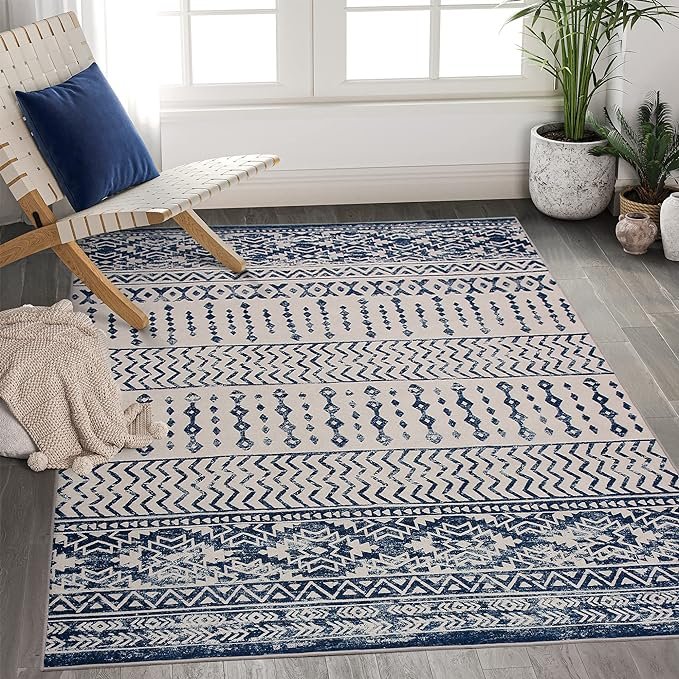Choosing the best hypoallergenic rugs or reworded, the best allergy rugs is an inevitable task, especially for those allergic to traditional rugs and carpets, whether indoors or outdoors. One must know what features or qualities to look out for when shopping for a new allergy-free rug.
For allergy sufferers, stepping inside their own homes shouldn’t feel like entering a minefield of sniffles and sneezes. Unfortunately, traditional carpets can harbor a hidden enemy: allergens like dust mites, pet dander, and pollen. These microscopic invaders can aggravate allergies, triggering a cascade of unpleasant symptoms that can significantly impact quality of life.
Hypoallergenic Rugs & Allergy Rugs vs Traditional Rugs
Hypoallergenic rugs (or allergy rugs) are emerging as a game-changer for allergy sufferers, offering a stylish and effective solution for creating a healthier indoor environment. You’re probably saying, no, there’s no such thing as hypoallergenic rugs or allergy rugs! But hang on as we guide you on how to scout for and purchase your first truly allergy rug!
We will discuss all things hypoallergenic rugs, exploring their benefits, how they work, and the different materials available. We’ll also provide valuable tips on choosing the right rug for your needs, maintaining it for optimal performance, and integrating it into an allergy-friendly home environment. So, take a deep breath (without the sniffles!), and let’s embark on a journey towards a more comfortable and allergy-free home.
Remember The Traditional Non-allergy Rugs and Carpets?

Here’s a closer look at the challenges posed by those traditional carpets:
- Deep Pile Havens for Allergens: Traditional carpets with thick, plush piles can trap allergens deep within their fibers. Vacuuming might remove some surface-level irritants, but it often struggles to reach the deeper layers where allergens can remain and multiply.
- Shedding Woes: Woven carpets, especially those made from natural fibers, can shed tiny fibers that further contribute to airborne allergens.
- Difficult Cleaning: Deep cleaning traditional carpets can be laborious and time-consuming, which can hinder the maintenance of a truly allergen-free environment.
What Do Allergy Rugs Such as Hypoallergenic Area Rugs Offer?
Hypoallergenic rugs, including area hypoallergenic area rugs, address these challenges by offering several key advantages:
- Reduced Allergen Trapping: These rugs are often made from materials with a tighter weave or lower pile, making it difficult for allergens to become lodged deep within the fibers.
- Easier Cleaning: Hypoallergenic rugs are typically easier to clean and maintain, allowing for more frequent allergen removal. Some may even be machine-washable for added convenience.
- Improved Indoor Air Quality: Hypoallergenic rugs can significantly improve your home’s overall indoor air quality by reducing allergen trapping and facilitating easier cleaning.
How Allergy Rugs Can Keep You Allergy-free
The beauty of allergy rugs lies in their ability to address a range of allergy triggers. Here’s a closer look at how these rugs offer targeted relief for some common allergies:
- Dust Mites: These microscopic creatures are a major culprit behind allergy symptoms like sneezing, itchy eyes, and runny nose. Dust mites thrive in warm, humid environments and feed on dead skin flakes. Traditional carpets provide the perfect breeding ground for them. Hypoallergenic rugs, with their tighter weave and low pile, make it difficult for dust mites to establish themselves, significantly reducing exposure and alleviating allergy symptoms.
- Pet Dander: Our furry companions bring us joy, but their shed skin flakes (dander) can trigger allergies in some individuals. Dander particles can easily become trapped in carpets, constantly releasing allergens into the air. Hypoallergenic rugs, with their smoother surfaces and easier cleaning capabilities, minimize pet dander accumulation, leading to a noticeable reduction in allergy symptoms for pet owners.
- Pollen Allergies: While pollen primarily comes from outdoor sources, it can hitch a ride on clothes and shoes and find its way into your home. Traditional carpets act as pollen traps, holding onto these allergens and potentially aggravating symptoms. Hypoallergenic rugs, with their easier cleaning and lower allergen-trapping capabilities, help minimize indoor pollen exposure, offering some relief for those suffering from seasonal allergies.
It’s important to note that while allergy rugs can significantly reduce allergen exposure, they might not be a complete solution for severe allergies. In some cases, additional strategies like allergy medication or working with an allergist to develop a personalized treatment plan might be necessary.
Best Hypoallergenic Rugs/Allergy Rugs of 2024
We’ve done all the work for you so you can spend more time dealing with the more serious things that matter! Here are our top 3 highly recommended hypoallergenic rugs, AKA allergy rugs, in the market this 2024!
Loloi’s Indoor/Outdoor Hypoallergenic Area Rugs

Features:
- This hypoallergenic area rug offers a bold and vibrant take on floral patterns, perfect for adding a touch of vintage charm to any space, indoors or outdoors.
- These durable rugs are crafted from stain-resistant polypropylene and polyester, making them ideal for high-traffic areas or outdoor use. With a low pile height, they’re easy to clean and maintain.
- Designed by Loloi, a leading rug company known for innovation and quality, these botanical rugs are a stylish way to add personality to your home.
- Hides dirt well.
- Soft and comfortable underfoot.
- Most importantly, a low pile of 0.18 inches!
The only con About this rug is that it doesn’t stick to the floor, but this can be solved by either placing furniture on it or gluing it to the floor.
Art & Tuft Morrocan Washable Allergy Rug

Features:
- Stain-resistant & Washable: Easily cleaned in a washing machine for long-lasting freshness.
- Super Soft & Comfortable: Machine-woven with finer fibers for a luxurious feel underfoot.
- Trendy Moroccan Design: Features a subtle abstract Moroccan pattern that complements any room.
- Kids & Pets Friendly: Low pile height (0.20″) makes it ideal for high-traffic areas and hides messes.
- Anti-Slip Backing & Non-Shedding: Anti-slip backing prevents sliding and ensures easy maintenance.
- Fits any room: Suitable for living room and bedrooms.
Con: Some buyers who opted for the larger-sized rug lamented that the rug wouldn’t fit inside their washing machines, so choose the size wisely.
Non-shedding Indoor/Outdoor Hypoallergenic rug

Features:
if you’re looking for a simple, no-mess hypoallergenic rug then this particular plain design should be on your top list.
- Soft Texture: Provides comfort for indoor and outdoor use.
- Easy to Clean: Low-maintenance polypropylene yarns allow for vacuuming, hosing, and air drying.
- Layering Friendly: Simple, solid design works well layered with patterned rugs.
- Low Pile: Lays flat quickly for easy furniture placement and doorway use.
- Multiple Sizes and Shapes: Runner, large, and round rug options are available.
This Moroccan-style Area Rug that is only 0.19 Inches

These rugs are the best rugs for allergies out there,
See other hypoallergenic rug choices here
Tips for Choosing the Right Hypoallergenic Rug for Your Needs
When it comes to reaping the full benefits of hypoallergenic rugs, selecting the right material is crucial. Here’s a breakdown of some popular options, along with their advantages and disadvantages:
- Synthetic Fibers (Nylon, Polyester, Polypropylene):
- Pros: These are some of the most common and affordable hypoallergenic rug materials. They boast a tight weave that effectively traps dust and allergens on the surface, making them easy to vacuum and clean. Additionally, synthetic fibers are naturally resistant to mold and mildew growth, which can further exacerbate allergies.
- Cons: Some people might find synthetic rugs less comfortable underfoot compared to natural fibers. Additionally, lower-quality synthetic materials can trap odors more easily and might require more frequent cleaning.
- Treated Wool:
- Pros: Wool is naturally flame-resistant and offers a luxurious feel underfoot. Modern wool rugs often undergo treatments that reduce allergens and dust mite growth. Treated wool rugs can be a good option for those who prefer the natural comfort of wool without allergy concerns.
- Cons: Even treated wool might not be hypoallergenic enough for people with severe wool allergies. Additionally, wool rugs can be more expensive than synthetic options and might require professional cleaning for optimal results.
- Natural Fibers (Cotton, Sisal):
- Pros: These materials offer a natural and eco-friendly alternative. Cotton rugs are particularly soft and comfortable, while sisal rugs offer a more textured feel. Natural fiber rugs are often breathable and can help regulate indoor temperature.
- Cons: While some natural fibers like cotton can be treated for allergen resistance, they generally don’t offer the same level of allergen-trapping as synthetic options. Additionally, natural fiber rugs might be more susceptible to moisture damage and require more delicate cleaning methods.
- Blends:
- Pros: Manufacturers often combine different materials to create hypoallergenic rugs that offer a balance of benefits. For example, a nylon and wool blend might provide the allergen-trapping properties of nylon with the comfort of wool.
- Cons: When choosing a blend, carefully review the material percentages. A rug with a higher percentage of natural fibers might not be as hypoallergenic as one with a higher percentage of synthetics.
Beyond the primary material, consider these additional factors when selecting a hypoallergenic rug:
- Pile Height: Opt for rugs with a low pile height, ideally not more than 0.30 inches. This allows for easier cleaning and reduces the amount of space for allergens to hide.
- Backing: Choose a hypoallergenic backing that prevents allergens from seeping through the rug and into the subfloor.
- Certifications: Look for rugs with certifications from reputable organizations like the Asthma & Allergy Foundation of America (AAFA) to ensure they meet specific hypoallergenic standards.

Comparison Table of Different Hypoallergenic Materials For Rugs
| Material | Pros | Cons |
|---|---|---|
| Synthetic Fibers (Nylon, Polyester) | * Affordable * Tight weave traps allergens on surface for easy cleaning * Naturally resistant to mold and mildew | * Less comfortable underfoot compared to natural fibers * Lower-quality synthetics might trap odors |
| Treated Wool | * Luxurious feel * Flame-resistant * Treated to reduce allergens and dust mites | * Might not be hypoallergenic enough for severe wool allergies * More expensive than synthetic options * May require professional cleaning |
| Natural Fibers (Cotton, Sisal) | * Natural and eco-friendly * Cotton: Soft and comfortable * Sisal: Textured feel * Breathable and regulates temperature | * Lower level of allergen-trapping compared to synthetics * Cotton might require allergen treatment * More susceptible to moisture damage * Delicate cleaning methods required |
| Blends | * Balance of benefits (e.g., nylon + wool) | * Carefully review material percentages for true hypoallergenic properties * Higher natural fiber content might reduce allergen-trapping |
Keeping Your Hypoallergenic Rug Clean and Effective
Hypoallergenic rugs are a valuable tool in your allergy management arsenal, but their effectiveness hinges on proper maintenance. Here’s how to ensure your rug stays clean and continues to provide optimal benefits:
- Regular Vacuuming: Frequent vacuuming is the cornerstone of maintaining a hypoallergenic rug. Aim to vacuum at least twice a week, focusing on high-traffic areas. Use a vacuum cleaner with a HEPA filter to capture even the tiniest allergens.
- Deep Cleaning Frequency: Depending on the material and your allergy severity, deep cleaning your hypoallergenic rug might be necessary every few months or once a year.
- Synthetic Rugs: Many synthetic rugs can be machine-washed on a gentle cycle using cold water and mild detergent. Always check the care label for specific instructions.
- Natural Fiber Rugs: Natural fiber rugs might require professional cleaning or more delicate methods like spot cleaning with a wool-safe carpet cleaner.
- Spot Cleaning: Address spills and accidents promptly to prevent stains and mold or mildew growth. Use a cleaning solution appropriate for the specific rug material and follow the manufacturer’s recommendations.
- Shaking it Out: Take your hypoallergenic rug outside occasionally and give it a good shake to remove any loose dirt or allergens trapped in the fibers.
- Consider a Rug Pad: Using a hypoallergenic rug pad can further enhance your rug’s effectiveness. Rug pads offer several benefits:
- Increased Comfort: A rug pad adds a layer of cushioning for a more comfortable feel underfoot.
- Improved Airflow: Rug pads promote air circulation beneath the rug, preventing moisture buildup and inhibiting mold growth.
- Reduced Shedding (for some materials): For some rugs, a rug pad can minimize fiber shedding, further reducing potential allergens.
- Preventative Measures: Beyond cleaning routines, consider implementing additional measures to minimize allergen exposure in your home:
- Take shoes off at the door: This prevents tracking in pollen and other outdoor allergens.
- Wash bedding frequently: Dust mites thrive in bedding. Wash sheets, pillowcases, and comforters weekly in hot water (at least 130°F/54°C) to kill dust mites.
- Control humidity levels: Use a dehumidifier to maintain indoor humidity between 30% and 50%. Dust mites thrive in humid environments.
- Air purifiers: Consider using air purifiers with HEPA filters to capture airborne allergens throughout your home.
By following these cleaning and preventative measures, you can ensure your hypoallergenic rug remains a powerful ally in your fight against allergies, offering long-lasting benefits and a healthier home environment.
Decorating Your Home With No-Allergy Rugs

No-allergy rugs or Hypoallergenic rugs offer powerful assistance for allergy management, but they don’t have to compromise on style. Here’s how to seamlessly integrate allergy rugs into your home, creating an environment that’s both beautiful and allergy-friendly:
Selecting the Right Rug for Different Rooms:
- Living Room: A low-pile, easy-to-clean synthetic or synthetic blend rug might be a good choice for the high-traffic living room. Consider a larger rug to define the space and create a cohesive feel.
- Bedroom: For a luxurious and anti-allergy rug option, a treated wool rug can offer both comfort and allergy relief. Choose a smaller rug to place at the foot of the bed or a larger one to cover most of the bedroom floor.
- Kitchen and Bathroom: Opt for washable and water-resistant options like synthetic or natural fiber blend rugs with rubber backing. These areas might require more frequent cleaning due to potential spills and moisture.
Aesthetics and Design:
- Colors and Patterns: Hypoallergenic rugs come in a variety of colors and patterns. Consider your existing décor and choose a rug that complements your overall aesthetic. Bold patterns can effectively hide dirt, while lighter colors might make a room feel more spacious.
- Textures: Low-pile rugs are generally easier to clean, but some people might prefer the more textured feel of natural fiber rugs like sisal. Experiment with different textures to find what feels comfortable underfoot in each room.
- Size and Shape: Measure your space carefully before purchasing a rug. The rug should be the right size for the room without overwhelming it. Consider the layout of your furniture and choose a rug shape (rectangular, round, etc.) that complements the flow of the room.
Creating an Allergy-Friendly Home Environment:
- Layer Your Defenses: Combine hypoallergenic rugs with other allergy-management strategies, such as air purifiers, regular dusting with damp cloths, and frequent curtain washing.
- Minimize Clutter: Clutter provides hiding places for dust mites and other allergens. Declutter your home and keep surfaces clear to minimize allergen accumulation.
- Invest in Allergy-Friendly Bedding: Look for bedding specifically designed for allergy sufferers, with materials like allergen-proof encasements for pillows and mattresses.
By carefully selecting your hypoallergenic rugs, considering aesthetics, and implementing additional allergy-management strategies, you can transform your home into a haven of comfort and relief, allowing you to breathe easier and enjoy your space to the fullest.
Approach to Allergy Management

While hypoallergenic rugs are a valuable tool in your fight against allergies, they shouldn’t be the sole line of defense. Here’s why consulting a doctor and adopting a holistic approach are crucial for optimal allergy management:
- Accurate Diagnosis: A doctor can properly diagnose your allergies through testing and determine the specific triggers. This allows for a more targeted approach to treatment and reduces the risk of focusing on managing the wrong allergens.
- Treatment Plans: Based on your diagnosis, your doctor can recommend a personalized treatment plan that might include medications like antihistamines or allergy shots. These strategies can work alongside hypoallergenic rugs to provide more comprehensive relief.
- Severity Management: For severe allergies, hypoallergenic rugs might be just one piece of the puzzle. Consulting a doctor ensures you’re implementing the most effective strategies to manage your allergies and minimize symptoms.
- Addressing Other Triggers: Allergies can be triggered by various factors beyond those addressed by hypoallergenic rugs. Your doctor can help you identify and address other potential triggers like food allergies, mold exposure, or seasonal allergies.
Here are some additional strategies to consider for a comprehensive approach:
- Air Filtration: Invest in air purifiers with HEPA filters to remove allergens circulating throughout your home.
- Dehumidification: Maintain proper humidity levels with a dehumidifier to prevent mold growth, which can exacerbate allergies.
- Dietary Changes: Identifying and eliminating foods from your diet can significantly reduce allergy symptoms if you have food allergies.
- Immunotherapy: In some cases, your doctor might recommend immunotherapy (allergy shots) to desensitize your immune system to specific allergens.
- Isolate other Culprits: Household items can also cause allergic reactions; knowing your triggers and isolating them would greatly improve your comfort around your home.
By combining hypoallergenic rugs with a doctor-recommended treatment plan and these additional strategies, you can create a truly allergy-friendly environment and experience significant improvement in your overall well-being.
Remember, hypoallergenic rugs are a powerful addition to your arsenal against allergies, but they work best as part of a comprehensive approach to allergy management.
Conclusion: Why You Need Allergy Rugs At Home
Living with allergies doesn’t have to mean constant sniffles and itchy eyes. Hypoallergenic rugs offer a welcome respite, creating a cleaner and healthier home environment. By understanding the materials, benefits, and proper maintenance practices, you can leverage these rugs to manage your allergies and breathe easier indoors effectively. Remember, consulting a doctor and adopting a holistic approach are crucial for achieving optimal allergy relief. So, take the first step towards a more comfortable and allergy-free home, and start breathing easy today!
References:
- Asthma & Allergy Foundation of America (AAFA): https://aafa.org/
- American College of Allergy, Asthma & Immunology (ACAAI): https://acaai.org/
- Environmental Protection Agency (EPA): https://www.epa.gov/indoor-air-quality-iaq
FAQS
1. Are wool rugs hypoallergenic?
Yes, wool rugs are often considered hypoallergenic. Wool naturally resists dust mites, mold, and mildew, common allergens in the home environment. However, individuals with sensitivities to wool’s natural fibers or lanolin may experience allergic reactions. While wool rugs can help reduce airborne allergens, those with wool sensitivities should be cautious.
2. Are polypropylene rugs hypoallergenic?
Polypropylene rugs, also known as olefin rugs, are synthetic and mimic the look of natural fibers. They do not absorb moisture, preventing mold and mildew growth and making them suitable for allergy sufferers. Their ease of cleaning and resistance to dust and dander accumulation make polypropylene rugs a hypoallergenic choice.
3. Are silk rugs hypoallergenic?
Silk rugs are hypoallergenic, offering an excellent option for individuals with allergies. The natural properties of silk fibers, including resistance to dust mites, mold, and mildew, contribute to their hypoallergenic status. Additionally, silk’s smooth, non-porous structure helps in reducing dust and allergen accumulation. However, silk rugs require careful maintenance to preserve their hypoallergenic benefits, as they are delicate and often come with a higher price tag.


